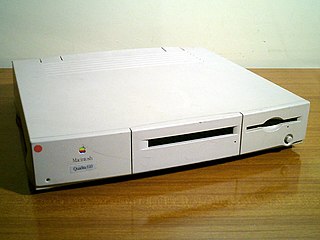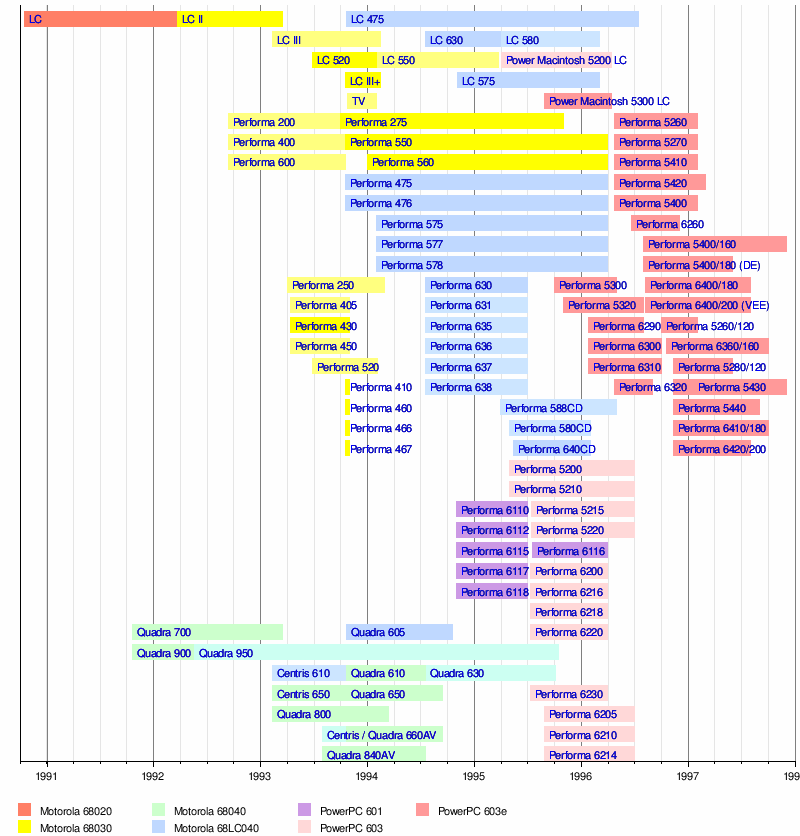
The Macintosh LC II is a personal computer designed, manufactured, and sold by Apple Computer from March 1992 to March 1993. The LC II is an update to the original Macintosh LC, replacing its Motorola 68020 processor with a 68030 and increasing the onboard memory to 4 MB. The LC II was priced at US$1,699, fully $800 less than the original LC when it was introduced.

The Macintosh Classic II was a personal computer designed and manufactured by Apple Computer, Inc. from October 1991 to September 1993. The system had a compact, appliance design with an integrated 9" monitor, typical of the earliest of the Macintosh range. A carrying handle moulded into the case added a degree of portability at a time when laptops were still relatively uncommon.

The Macintosh IIvx is a personal computer designed, manufactured and sold by Apple Computer from October 1992 to October 1993. It is the last of the Macintosh II family of Macintosh computers. The IIvx was introduced at the same time as the Macintosh IIvi, with both models using the same metal case design as the earlier Performa 600 and Performa 600CD. Like the Performa 600CD, the IIvx could be equipped with an internal double-speed CD-ROM drive.

The Macintosh IIvi is a personal computer designed, manufactured, and sold by Apple Computer from September 1992 to February 1993. The IIvi was introduced alongside the Macintosh IIvx, using a slower Motorola 68030 processor and no floating point unit. The Performa 600 models, meanwhile, are the IIvi with the IIvx's 32 MHz CPU. The IIvi was, on some benchmarks, faster than the IIvx. It is the only model in the Macintosh II family to be branded as a Performa.

The Power Macintosh 6100 is a personal computer designed, manufactured and sold by Apple Computer from March 1994 to March 1996. It is the first computer from Apple to use the new PowerPC processor created by IBM and Motorola. The low-profile ("pizza-box") case was inherited from the Centris/Quadra 610 and 660AV models, and replaced the Macintosh Quadra series that used the Motorola 68040 processor, Apple's previous high-end workstation line.

The Macintosh LC III is a personal computer designed, manufactured, and sold by Apple Computer from February 1993 to February 1994. It replaced the commercially successful Macintosh LC II in Apple's lineup of mid-class computers, and was significantly faster, with MacWorld Magazine benchmarks showing 2x performance in all major categories - CPU, disk, video and maths. It was also significantly less expensive; the LC III with an 80 MB hard disk was priced at US$1,349 at introduction, $700 less than the LC II. The LC III was sold primarily to educational institutions, and a corresponding Performa variant called the Performa 450 was sold to the consumer market.

The PowerBook 3400c is a laptop computer in the PowerBook line manufactured by Apple Computer from February to November 1997. It was briefly the fastest laptop in the world. Using the PowerPC 603e processor running at speeds of up to 240 MHz, this PowerBook was the first to feature a PCI architecture, EDO memory, and a 64-bit wide, 40 MHz internal bus. It was also the first PowerBook to feature a PC card slot capable of being used as a zoomed video port. Like all Apple laptops since the PowerBook 500 series, it featured a built-in trackpad as the pointing device.

The Macintosh Quadra 605 is a personal computer designed, manufactured, and sold by Apple Computer from October 1993 to July 1996. The model names reflect a decision made at Apple in 1993 to follow an emerging industry trend of naming product families for their target customers – Quadra for business, LC for education, and Performa for home. Accordingly, the Performa 475 and 476 was sold in department stores and electronics stores such as Circuit City, whereas the Quadra was purchased through an authorized Apple reseller.

The Power Macintosh 9500 is a personal computer designed, manufactured and sold by Apple Computer from June 1995 to February 1997. It is powered by a PowerPC 604 processor, a second-generation PowerPC chip which is faster than the PowerPC 601 chip used in the Power Macintosh 8100. The 180MP and 200 MHz models, introduced August 1996, use the enhanced PowerPC 604e processor.

The Power Macintosh 4400 is a personal computer designed, manufactured and sold by Apple Computer, Inc. from November 1996 to February 1998. It differs from prior desktop Macintosh models in that it was built with industry-standard components such as an IDE hard drive and an ATX-like power supply.

The Macintosh Quadra 630 is a personal computer designed, manufactured and sold by Apple Computer from July 1994 to October 1995. It was introduced as the replacement for the Quadra 610, and was the least-expensive computer in the Macintosh lineup with prices starting at $1,199 USD.

The Macintosh Quadra 610, originally sold as the Macintosh Centris 610, is a personal computer designed, manufactured and sold by Apple Computer from February 1993 to July 1994. The Centris 610 was introduced alongside the larger Centris 650 as the replacement for the Macintosh IIsi, and it was intended as the start of the new midrange Centris line of computers. Later in 1993, Apple decided to follow an emerging industry trend of naming product families for their target customers – Quadra for business, LC for education, and Performa for home – and folded the Centris 610 into the Quadra family.

The Macintosh Quadra 650, originally sold as the Macintosh Centris 650, is a personal computer designed, manufactured and sold by Apple Computer from February 1993 to September 1994. The Centris 650 was introduced alongside the smaller Centris 610 as the replacement for the Macintosh IIci and Quadra 700, and it was intended as the start of the new midrange Centris line of computers. Later in 1993, Apple decided to follow an emerging industry trend of naming product families for their target customers – Quadra for business, LC for education, and Performa for home – and folded the Centris 650 into the Quadra family.
The Macintosh LC 500 series is a series of personal computers that were a part of Apple Computer's Macintosh LC family of Macintosh computers, designed as a successor to the compact Macintosh family of computers for the mid-1990s mainstream education-market. The all-in-one desktop case is similar to the then recently introduced Macintosh Color Classic, but the LC 500 series is considerably larger and heavier due to its larger screen and a bulging midsection to house the larger electronics, including a 14" CRT display, CD-ROM drive, and stereo speakers.

The Power Macintosh 5200 LC and Power Macintosh 5300 LC were a line of personal computers that are a part of Apple Computer's Power Macintosh, LC, and Performa families of Macintosh computers. When sold to the consumer market, the machines were marketed as variations of Performa 5200 and Performa 5300.

The Power Macintosh 5260 is a personal computer designed, manufactured and sold by Apple Computer, Inc. from April 1996 to March 1997. It is a replacement for the Power Macintosh 5200 LC, retaining its all-in-one form factor while replacing its PowerPC 603 CPU with the newer and faster PowerPC 603e, and dropping the "LC" brand. As was standard practice at the time for Apple, the 5260 was re-branded as a number of Performa models and sold to consumer markets, while the 5260 itself was primarily sold to the North American education market as a Power Macintosh.

The Power Macintosh 5500 is a personal computer designed, manufactured, and sold by Apple Computer from February 1997 to March 1998. Like the Power Macintosh 5260 and 5400 that preceded it, the 5500 is an all-in-one design, built around a PowerPC 603ev processor operating at 225, 250 or 275 megahertz (MHz).
The Power Macintosh 5400 is a personal computer designed, manufactured and sold by Apple Computer from April 1996 to March 1998. The 5400 is an all-in-one computer with an integrated monitor, and replaced the Power Macintosh 5200 LC in that role. It is largely identical to the Power Macintosh 6400 internally, which is essentially the same computer in a tower case. This is the first all-in-one Macintosh to support PCI expansion, replacing the Processor Direct Slot.

The Apple Communication Slot, or Comm Slot, is an internal expansion data interface (slot) found in Apple Macintosh computers from the early to mid-1990s. It was designed as an inexpensive way to add communication expansion cards like network adapters or modems to Macs and Power Macs.

The Power Macintosh 6400 is a personal computer designed, manufactured and sold by Apple Computer from August 1996 to August 1997. It is the only Macintosh mini-tower system to be branded as a Performa, and alongside the Performa 6360 was the last new Performa-branded model introduced by Apple.






















